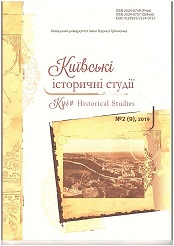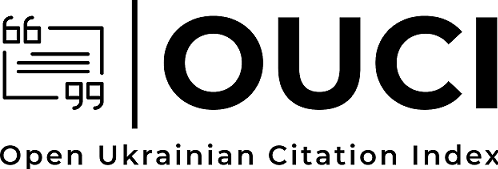KARPATIAN UKRAINE AS A FACTOR IN THE PROCESS OF TRANSFORMATION THE POLITICAL CONFIGURATION IN CENTRAL EUROPE ON THE EVE OF WORLD WAR II
DOI:
https://doi.org/10.28925/2524-0757.2019.2.9Keywords:
Carpathian Ruthenia, Munich Conference, Czechoslovakia, Germany, Saint-Germain, Treaty, Ukrainian state-buildingAbstract
The article studies the Carpathian Ukraine’s factor in the policy of European countries according to the political configuration in the Central Europe in late 1930s after the Munich Conference, 30 September — 2 October, 1938. The author has used both historical research methods and methodological techniques of jurisprudence. It is analysed international legal documents, in particular, the Treaties of Saint-Germain and Trianon determining the Central Europe’s policy after the end of World War I. The provisions of the Czechoslovak Constitution of 1920 are also analysed. The process of revising the Treaty of Saint-Germain and initiating the revision of the Treaty of Trianon determining the Carpathian Ukraine’s status iss analysed. It is underlined the German and Italian positions on the Carpathian Ruthenia’s situation. Diplomatic correspondence of the German Ministry of Foreign Affairs, covering the position of not only Germany but also Italy, Poland, Hungary, and Romania appealing to the Central Europe’s policy after launching the procedure of revising the peace treaties summing up the results of World War I, is used to address that problem. It is analysed the political and legal conditions of the Ukrainian state-established forces triying to realize the right to self-determination of the Ukrainian people in the Carpathian Ruthenia. The study of the problem of the Carpathian Ukraine’s factor in the policies of big European states with respect to structuring the Central Europe’s policy reveals that the strengthening of the policies of Poland and Italy towards the regional bloc foundation became possible after the Munich Conference of 1938. Such bloc provided for strategic consolidation of such Central European countries as Poland (which was expected to play a leading role in that bloc), Hungary, and Romania, while Italy assigned itself the role of a strategic partner of the bloc. However, the fact of existence of the Carpathian Ukraine (initially, as an autonomous territory within Czechoslovakia) obstructed such geopolitical formation. The bloc in the Central Europe with Polish domination and Italian strategic partnership was wholly at odds with geopolitical interests of Germany. Actually, that was the reason behind German support to the Carpathian Ukraine. However, the change in the German strategic plans regarding the future of Poland caused the revision of the policy to support the Carpathian Ukraine.
Downloads
References
Ciano, G. (2002). Diary. 1937–1943. N.-Y.: Enigma books [in English].
Bernadotte, E., Schmitt & Hon., Margaret Lambert & others (Eds.) (1953). Ministerialdirektor Wohlthat to Ministerialdirektor Wiehl. Berlin, December 1, 1938. Documents on the German Foreign Policy 1918–1945, Series D. (1937–1945), Volume V, Poland; the Balkans; Latin America; The Smaller Powers June 1937– March 1939, 345, Washington: United States Government printing office [in English].
Ilski, Z. & Malkewicz, A. (2015). Problem autonomii Zakarpacia w okresie przynaleznosci do Czechoslowacji (1919–1939). Rehionalna polityka: zakonodavche rehuliuvannia ta praktychna realizatsiia: materialy Pershoi Mizhnar. nauk-prakt. konf. (Kyiv, 24–25 lystopada 2015 r.), 284–298, K.-Ternopil: Aston [in Polish].
John W. Wheeler-Bennett & Raymond James Sontag & others (Ed.) (1951). The Chargé ď Affaires in Czechoslovakia to the Foreign Ministry. Telegram. Prague, October 17, 1938. Documents on German Foreign policy, 1918–1945. From the archives of the German Foreign Ministry. Series D (1937–1945), Volume IV, The aftermath of Munich. October 1938–March 1939, 81, Washington: United States Government printing office 81 [in English].
John W. Wheeler-Bennett & Raymond James Sontag & others (Ed.) (1951). The Minister in Hungary to the Foreign Ministry. Telegram. Budapest, October 20, 1938. Documents on German Foreign policy, 1918–1945. From the archives of the German Foreign Ministry, Series D (1937–1945), Volume IV, The aftermath of Munich, October 1938–March 1939, 94, Washington: United States Government printing office [in English].
John W. Wheeler-Bennett & Raymond James Sontag & others (Ed.) (1951). Memorandum by an Official of the Foreign Minister`s Personal Staff. Munich, October 14, 1938. Documents on German Foreign policy, 1918–1945. From the archives of the German Foreign Ministry, Series D (1937–1945), Volume IV, The aftermath of Munich, October 1938–March 1939, 73, Washington: United States Government printing office [in English].
John W. Wheeler-Bennett & Raymond James Sontag & others (Ed.) (1951). Memorandum by an Official of the Foreign Minister`s Personal Staff. Munich, October 19, 1938. Documents on German Foreign policy, 1918–1945. From the archives of the German Foreign Ministry, Series D (1937–1945), Volume IV, The aftermath of Munich, October 1938–March 1939, 90–91, Washington: United States Government printing office [in English].
John W. Wheeler-Bennett & Raymond James Sontag & others (Ed.) (1951). Circular of the State Secretary. Telegram. Berlin, October 3, 1938. Documents on German Foreign policy, 1918–1945. From the archives of the German Foreign Ministry, Series D (1937–1945), Volume IV, The aftermath of Munich. October 1938 –March 1939, 18, Washington: United States Government printing office [in English].
John W. Wheeler-Bennett & Raymond James Sontag & others (Ed.) (1951). Circular of the Director of the Political Department. Telegram. Berlin, October 1, 1938. Documents on German Foreign policy, 1918–1945. From the archives of the German Foreign Ministry, Series D (1937–1945), Volume IV, The aftermath of Munich. October 1938–March 1939, 8, Washington: United States Government printing office [in English].
John W. Wheeler-Bennett & Raymond James Sontag & others (Ed.) (1951). Circular of the State Secretary. Telegram. Berlin, October 10, 1938. Documents on German Foreign policy, 1918–1945. From the archives of the German Foreign Ministry, Series D (1937–1945), Volume IV, The aftermath of Munich. October 1938 –March 1939, 52, Washington: United States Government printing office [in English].
John W. Wheeler-Bennett & Raymond James Sontag & others (Eds.) (1951). The Chargé ď Affaires in Czechoslovakia to the Foreign Ministry. Telegram. Prague, October 4, 1938. Documents on German Foreign policy, 1918–1945. From the archives of the German Foreign Ministry, Series D (1937–1945), Volume IV, The aftermath of Munich, October 1938–March 1939, 31, Washington: United States Government printing office [in English].
John W. Wheeler-Bennett & Raymond James Sontag & others (Eds.) (1951). Memorandum by the States Secretary. Berlin, October 1, 1938. Documents on German Foreign policy, 1918–1945. From the archives of the German Foreign Ministry. Series D (1937–1945), Volume IV, The aftermath of Munich, October 1938 –March 1939, Washington: United States Government printing office, 1951,p. 8 [in English].
John W. Wheeler-Bennett & Raymond James Sontag & others (Eds.) (1951). Memorandum by the Director of the Political Department. Berlin, October 7, 1938. Documents on German Foreign policy, 1918–1945. From the archives of the German Foreign Ministry, Series D (1937–1945), Volume IV, The aftermath of Munich. October 1938–March 1939, 48, Washington: United States Government printing office [in English].
John W. Wheeler-Bennett & Raymond James Sontag & others (Eds.) (1951). Note verbale from the British Embassy. Berlin, 1st October, 1938. Documents on German Foreign policy, 1918–1945. From the archives of the German Foreign Ministry, Series D (1937–1945), Volume IV, The aftermath of Munich. October 1938 — March 1939, 7, Washington: United States Government printing office [in English].
Lloyd-Dzhordzh, D. (1957). Pravda o mirnykh dogovorakh. Vol. 2, M.: Izdatelstvo inostrannoi literatury [in Russian].
Maltsev, V. & Spachil, D. & other. (Ed.). (1979). Soglashenie, zakliuchennoie mezhdu Germaniei, Velikobritaniei, Frantsiei i Italiey v Miunkhene. 29 sentiabria 1938 g. Dopolnitelnaia deklaratsiia, # 1, Dokumentyi po istorii miunhenskogo sgovora, 1937–1939, 331, M.: Izdatelstvo politicheskoi literatury [in Russian].
Marina, V. (2003). Zakarpatskaia Ukraina (Podkarpatskaia Rus) v politike Benesha i Stalina. 1939–1945. Dokumentalnyi ocherk. M.: Novyi khronograf [in Russian].
Naumov, A. (2007). Diplomaticheskaia borba v Yevrope nakanune Vtoroi mirovoi voiny. M.: ROSSPEN [in Russian].
Nikolson, G. (1945). Kak delalsia mir v 1919 g. M.: Gospolitizdat, 150 p. [in Russian].20. Pushkash, A. (2006). Tsivilizatsiia ili varvarstvo: Zakarpatie 1918–1945. M.: Izdatelstvo «Yevropa» [in Russian].
Pushkash, A. (Ed.). (1962). Shifrovannaia telegramma ministra inostrannykh del Kalmana Kanya poslanniku v Chehoslovakii Yanoshu Vetshteinu. Budapesht, 3 oktiabria 1938 g. Vengriia i Vtoraia mirovaia voina. Sekretnyie diplomaticheskie dokumenty po istorii kanuna i perioda voiny, 111, M.: Izdatelstvo inostannoi literatury [in Russian].
Pushkash, A. (Ed.). (1962). Shifrovannaia telegramma nachalnika kantseliarii ministra inostrannykh del Vengrii Ishtvana Chaki ministru inostrannykh del Vengrii Kalmanu Kanya. Rim, 14 oktiabria 1938 g., 114. Vengriia i Vtoraia mirovaia voina. Sekretnyie diplomaticheskie dokumenty po istorii kanuna i perioda voiny. M.: Izdatelstvo inostannoi literatury (in Russian).
Stercho, P. (1994). Karpato-ukrainska derzhava: do istorii vyzvolnoi borotby karpatskykh ukraintsiv u 1919–1939 rokakh. Lviv: «Za vilnu Ukrainu» [in Ukraian].24. Zákon ze dne 29. února 1920, kterým se uvozuje Ústavní listina Československé republiky [in Czech]. https://www.psp.cz/docs/texts/constitution_1920.html
Zemskov, I. & others. (Ed.). (1981). Zapis besedy A. Gitlera s premier-ministrom Velikobritanii N. Chemberlenom. 22 sentiabria 1938 g. Dokumenty i materialy kanuna Vtoroi mirovoi voyny. 1937–1939, Vol. 1, 201–210, M.: Izdatelstvo politicheskoi literatury [in Russian].
Published
How to Cite
Issue
Section
License
Copyright (c) 2019 Kyiv Historical Studies

This work is licensed under a Creative Commons Attribution-NonCommercial-ShareAlike 4.0 International License.
Authors who publish in this journal retain the right of authorship of the work and give to the journal right of first publication of this work under the conditions of Creative Commons: Attribution-NonCommercial-ShareAlike 4.0 International (CC BY-NC-SA 4.0), which allows others freely distribute the work published with reference to the authors of the original work and the first publication of this magazine.














